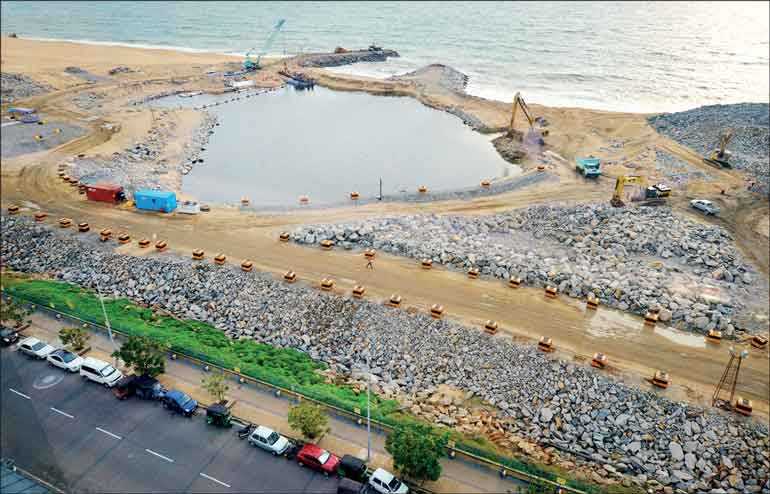Wednesday Jul 02, 2025
Wednesday Jul 02, 2025
Saturday, 21 November 2020 00:04 - - {{hitsCtrl.values.hits}}

The cumulative value of Chinese infrastructure investment to Sri Lanka was about $ 13 billion between 2006 and August 2020, (equivalent to 15% of Sri Lanka’s GDP in 2019). Some projects have brought greater benefits to Sri Lanka than others, such as the Colombo International Container Terminal (CICT). The adjacent Colombo Port City (CPC), built on reclaimed land from the sea, could be a game changer for modern service sector growth and post-COVID economic recovery – Pic by Shehan Gunasekara
 US concerns have been brewing about China’s growing interest in Sri Lanka in the economic and possibly security spheres.
US concerns have been brewing about China’s growing interest in Sri Lanka in the economic and possibly security spheres.
Days before the US Presidential Election, during a high-profile visit, US Secretary of State Mike urged Sri Lanka strategically located in the centre of the Indian Ocean to make difficult but necessary choices with regard to its relationship with China.
With President Biden due to assume office in late January 2021 and the Chinese economy projected to recover from the COVID-19 pandemic faster than the world economy in 2021, it seems useful to look at the state of China-Sri Lanka relations and to explore a strategic reset involving major powers.
Concerns about China ties
China and Sri Lanka enjoyed warm diplomatic ties since Sri Lanka recognised China in 1950, supported China’s accession to the UN and signed a rubber-rice barter deal in 1952. But China’s remarkable global economic assent since opening up to foreign trade and investment in the late 1970s, inevitably led to a shift in its diplomatic relations with Sri Lanka into a commercial direction.
Several concerns have been expressed internationally about the state of China-Sri Lanka ties:
One rather controversial issue concerns a Chinese debt trap. Since the early 2000s, China has become an important provider of commercial loans to Sri Lanka for infrastructure projects. There are claims that by accepting such loans that Sri Lanka is stuck in a ‘debt trap’.
Sri Lanka is not in a Chinese debt trap. The latest available data suggest that Sri Lanka’s external public debt owed to China amounted to $ 5 billion in 2018 (equivalent to about 6% of its GDP). Sri Lanka owes more of its external public debt to financial markets as well as multilateral and bilateral lenders than to China. Sri Lanka’s generally high debt to GDP ratios over the past decade reflects the costs of a 30-year civil conflict which ended in 2009, lacklustre post-conflict growth and notable currency depreciation.
A second issue relates to the economic impact of China’s signature Belt and Road (BRI) projects on host developing countries like Sri Lanka. Some analysts have labelled BRI investments as ‘white elephant projects’ which have contributed little or no economic benefits to host countries. The cumulative value of Chinese infrastructure investment to Sri Lanka was about $13 billion between 2006 and August 2020 (equivalent to 15% of Sri Lanka’s GDP in 2019).
Many projects predate the BRI initiative which was formally launched in 2013. Clearly, some projects have brought greater benefits to Sri Lanka than others, such as the Colombo International Container Terminal (CICT), which has allowed the deep-water Colombo Port to become South Asia’s premier transhipment hub. The adjacent Colombo Port City (CPC), built on reclaimed land from the sea, could be a game changer for modern service sector growth and post-COVID economic recovery.
The Hambantota Port, under new management, is likely to add to Sri Lanka’s port capacity as Colombo Port is nearing capacity limits. However, the economic benefits of the Colombo Lotus Tower, a delayed telecommunications and leisure project, seem less clear.
Moreover, rising imported inputs from China for construction projects in Sri Lanka have widened the significant trade deficit between the two countries. There are also less visible economic spillovers from Chinese projects in terms of foreign investment from China into the Sri Lankan manufacturing sector, technology transfer and local job creation.
Third, is India’s worry that a growing Chinese footprint risks violating Sri Lanka’s sovereignty and threatens India’s Southern flank and its national security. Visits by two Chinese submarines to Colombo Port in 2014 prompted a diplomatic discussion between India and Sri Lanka.
Concerns that Hambantota Port managed by a Chinese State-Owned Enterprise could become a dual use commercial/military facility have heightened following India-China skirmishes in the Himalayas. In an attempt to reassure India, Sri Lanka’s Navy manages port calls by foreign ships and security at Hambantota Port. India-Sri Lanka defence cooperation has been bolstered by regular defence dialogues, navy exercises and training in India for the Sri Lankan armed forces.
Fourth, is the recent claim that China is using so-called ‘pandemic diplomacy’ to advance its interests in countries like Sri Lanka. For instance, Communist Party Politburo Member Yang Jiechi visited Sri Lanka just after Pompeo and provided a $ 90 million grant for medical care, education and water supplies to tackle the COVID-19 pandemic. This comes on top of two China Development Bank loans to Sri Lanka in 2020 of $ 500 for general budget support and $ 140 million to the State-owned Bank of Ceylon.
Meanwhile, the US has donated $ 6 million in COVID assistance to Sri Lanka but remains Sri Lanka’s largest export market and has helped to improve Sri Lanka’s maritime surveillance capabilities by gifting of two coast guard cutters to the Sri Lanka Navy and training.
Balancing relations with the US and China
President Gotabaya Rajapaksa has congratulated President-elect Joe Biden and said that he looked forward to working with him. But, amid a likely continuation of US-China trade and technology rivalries in 2021 and beyond, the Biden administration may expect Sri Lanka to match words with deeds.
As a small state without a large military, Sri Lanka should adhere to a strict non-aligned foreign policy in its relations with great powers emulating the success of Singapore and New Zealand. Furthermore, Sri Lanka should pursue transparent, market-oriented policies to reassure US, India and other investors.
Export-oriented inward investment is critical to Sri Lanka’s post-pandemic economic recovery. To ally India’s security concerns, the feasibility of a maritime safety and security pact involving India, Sri Lanka and the Maldives may be explored. These policy steps could enable Sri Lanka to work more smoothly with the US in areas like trade and the regional maritime order as well as to leverage a recovering China as an engine for post-pandemic economic recovery.
In the case of China, this would require moving over time from foreign borrowing relationship to one emphasising trade and investment. The future agenda includes attracting Chinese investment into the industrial zone adjacent to Hambantota Port, concluding a bilateral free trade agreement on favourable market access terms for Sri Lankan exporters thereby reducing the trade deficit favouring China, and encouraging technology transfer from China to modernise Sri Lanka’s lagging agricultural sector to ensure food security. Better infrastructure master planning and capacity building would enhance the gains from BRI projects to Sri Lanka.
To reduce any risk of a future Chinese debt trap, Sri Lanka should negotiate debt standstills with its creditors, improve its borrowing and debt management systems, and build its external reserve buffers by prudent macroeconomic management.
[Dr. Ganeshan Wignaraja is a Senior Research Associate at the Overseas Development Institute (ODI) in London.]
Discover Kapruka, the leading online shopping platform in Sri Lanka, where you can conveniently send Gifts and Flowers to your loved ones for any event including Valentine ’s Day. Explore a wide range of popular Shopping Categories on Kapruka, including Toys, Groceries, Electronics, Birthday Cakes, Fruits, Chocolates, Flower Bouquets, Clothing, Watches, Lingerie, Gift Sets and Jewellery. Also if you’re interested in selling with Kapruka, Partner Central by Kapruka is the best solution to start with. Moreover, through Kapruka Global Shop, you can also enjoy the convenience of purchasing products from renowned platforms like Amazon and eBay and have them delivered to Sri Lanka.
Discover Kapruka, the leading online shopping platform in Sri Lanka, where you can conveniently send Gifts and Flowers to your loved ones for any event including Valentine ’s Day. Explore a wide range of popular Shopping Categories on Kapruka, including Toys, Groceries, Electronics, Birthday Cakes, Fruits, Chocolates, Flower Bouquets, Clothing, Watches, Lingerie, Gift Sets and Jewellery. Also if you’re interested in selling with Kapruka, Partner Central by Kapruka is the best solution to start with. Moreover, through Kapruka Global Shop, you can also enjoy the convenience of purchasing products from renowned platforms like Amazon and eBay and have them delivered to Sri Lanka.